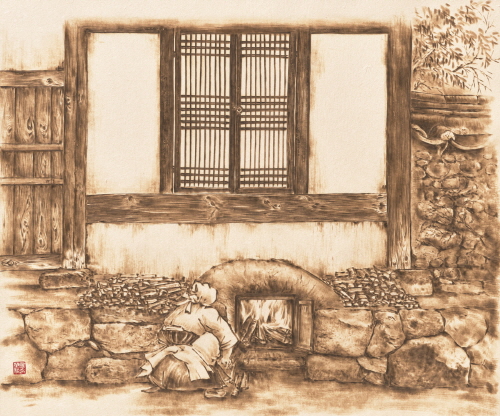Korea's heating system Ondol
차민서 /
2023-10-14
HERITAGE
조회수 1003
-


-
Hello! My name is Minseo Cha and I am from Usco. Usco means youth storyteller culture organization. I will explain the Ondol culture, which is registered as a national intangible cultural property, a cultural heritage of Korea. Ondol is Korea's traditional underfloor heating system, dating back over 1,000 years. It began during the Goguryeo period when Koreans heated stones and placed them under floors. This practical innovation spread across Korea, evolving into the Ondol system we know today. The word "ondol" means "warm stone" in Korean, reflecting its roots in using heated stones for warmth. 안녕하세요 제 이름은 차민서이고 저는 유스코에서 왔습니다. 유스코는 youth storyteller culture organization 의 줄임말 입니다. 저는 한국의 문화유산인, 국가무형문화재로 등록되어있는 온돌 문화에 대한 내용을 설명하겠습니다. 온돌은 1,000년 이상 거슬러 올라가는 한국의 전통적인 바닥 난방 시스템입니다. 그것은 한국인들이 돌을 데워서 바닥에 놓았던 고구려 시대에 시작되었습니다. 이 실질적인 혁신은 한국 전역에 퍼졌고, 오늘날 우리가 아는 온돌 시스템으로 발전했습니다. "온돌"은 한국어로 "따뜻한 돌"을 의미하며, 따뜻함을 위해 데워진 돌을 사용하는 것에 대한 뿌리를 반영합니다. https://www.heritage.go.kr/unisearch/images/imp_intangible_cult_prop/2022020815053900.jpg https://www.heritage.go.kr/unisearch/images/imp_intangible_cult_prop/2021072914540300.jpg 사진출처: 문화재청 국가문화유산포털
-


-
Ondol operates on several key principles. First, a network of underfloor channels is constructed, typically using clay or other heat-retaining materials. These channels are connected to a heat source, traditionally a wood or coal fire, but modern versions may use electricity or hot water. The heat source warms the channels, and due to the thick floor structure, this warmth is effectively retained. As the floor heats up, it radiates heat into the living space, creating a comfortable and even warmth throughout the room. Natural convection then occurs, with warm air rising and circulating, enhancing the heating efficiency and overall comfort. 온돌은 몇 가지 중요한 원칙에 따라 작동합니다. 첫째, 보통 점토나 다른 열을 유지하는 재료를 사용하여 바닥 아래의 수로 네트워크를 만듭니다. 이 수로들은 전통적으로 나무나 석탄 불 같은 열원에 연결되어 있지만, 현대판은 전기나 온수를 사용할 수 있습니다. 열원은 수로를 따뜻하게 하고 두꺼운 바닥 구조 때문에, 이 온기는 효과적으로 유지됩니다. 바닥이 뜨거워지면 거주 공간으로 열을 방출하고, 방 전체에 편안하고 심지어 따뜻함을 만들어냅니다. 그 다음 따뜻한 공기가 상승하고 순환하면서, 자연 대류가 일어나 난방 효율과 전반적인 쾌적함을 향상시킵니다. https://www.heritage.go.kr/unisearch/images/tangible_cult_prop/2022061313364904.jpg https://www.heritage.go.kr/unisearch/images/tangible_cult_prop/2022061313364801.jpg 사진출처: 문화재청 국가문화유산포털
-


-
My house and many Korean structures include this ondol. If you turn on the heating button in Korea, of course, the ondol will work and the floor will be warm. There is an ondol like this in apartments like my house, so how did the ondol come from, and why did it become popular? In my case, I actually learned this ondol in science class. 저희 집, 그리고 많은 한국의 건축물들은 대부분 이 온돌을 포함하고 있습니다. 난방 버튼을 키면 당연하게도 온돌이 작동되어 바닥이 따뜻해진다고 생각하면 됩니다. 제 집 같은 아파트에도 이런 온돌이 있는데, 온돌은 어떤 원리로 생긴 것이고, 왜 유행을 하게 되었을까요? 저 같은 경우는 과학시간에 실제로 이 온돌을 배우기도 했습니다. drawing by Minseo
-


-
In short, it uses the heat of the place where rice is cooked, such as a furnace, which was also used in the palace in Korea in the past. You can actually see the furnace of the palace and think that it has to do with the ondol! This useful and effective ondol is also gaining popularity around the world, so if you have a chance, pay attention to a heating system called the ondol. 한마디로 아궁이와 같은 밥을 짓는 곳의 열을 이용하는데, 이것은 한국 과거의 궁궐에서도 사용했던 방식입니다. 실제로 궁궐의 아궁이를 보며 온돌과 연관이 있겠구나 생각하실 수 있는 셈이죠! 이 유용하고 효과적인 온돌은 전세계적으로도 인기를 끌고 있으니 기회가 된다면 온돌이란 난방 시스템에 관심을 가져보세요. drawing by Minseo